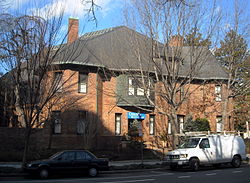Whittemore House | |
 Whittemore House in 2009 | |
| Location | 1526 New Hampshire Avenue, N.W. Washington, D.C. |
|---|---|
| Coordinates | 38°54′38.49″N77°2′32.88″W / 38.9106917°N 77.0424667°W |
| Built | 1894 |
| Architect | Harvey L. Page |
| Architectural style | Shingle style |
| Part of | Dupont Circle Historic District (ID78003056) |
| NRHP reference No. | 73002126 |
| Added to NRHP | July 16, 1973 [1] |
Whittemore House (also known as the Walter D. Wilcox House and the John C. Weeks House) is an historic building located at 1526 New Hampshire Avenue, N.W., in the Dupont Circle neighborhood of Washington, D.C. The former private residence, whose previous occupants include a musician, several politicians, and a mountain explorer, now serves as a historic house museum and headquarters of the Woman's National Democratic Club (WNDC).
